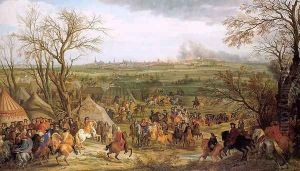Workshop of Adam-Franz van der Meulen Paintings
Adam-Franz van der Meulen was a Flemish Baroque painter who specialized in landscapes, battle scenes, and siege warfare. Born in Brussels in 1632, van der Meulen was a student of the prominent landscape painter Pieter Snayers, a follower of Peter Paul Rubens. His early work is characterized by detailed landscapes and depictions of military engagements, influenced by his teacher's style.
Van der Meulen moved to Paris in 1664 upon the recommendation of Charles Le Brun, the leading French artist and artistic director at the Manufacture des Gobelins, the royal tapestry factory. He was commissioned to record the military campaigns of King Louis XIV, which earned him the title of 'Peintre ordinaire des batailles du roi', essentially becoming the official painter of the king's battles. His role was to glorify the king's military achievements through art.
His workshop in Paris became a center of production for courtly commissions, producing paintings, tapestries, and prints that celebrated the king's conquests. Van der Meulen's works were instrumental in the development of the Louis XIV style and served as a form of propaganda, emphasizing the might and glory of the French monarchy. His paintings often depicted expansive landscapes with minute details of the army's operations, showcasing his ability to combine accuracy with grandeur.
Adam-Franz van der Meulen's style influenced many court painters across Europe and his workshop was a hub for artists to learn the genre of military painting. He continued to work for the king until his death in Paris in 1690. His legacy includes a significant contribution to the visual culture of the Sun King's reign and the tradition of European battle painting. Despite his death, his workshop, known as the 'Workshop of Adam-Franz van der Meulen', carried on his distinctive style and thematic focus, with his students and followers producing works that were often attributed to van der Meulen himself.
